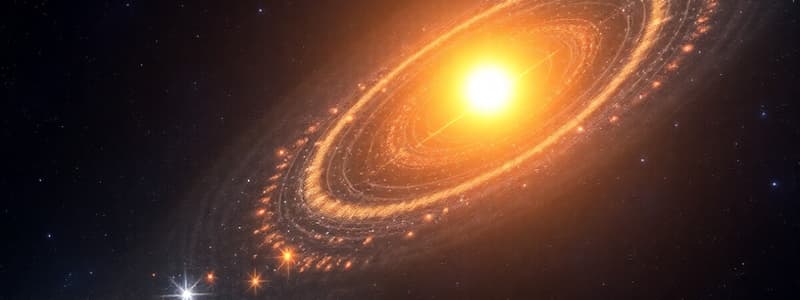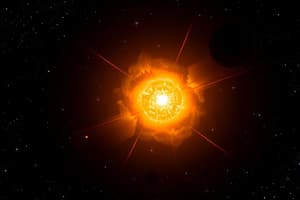Podcast
Questions and Answers
What is the primary factor that determines a star's position on the main sequence?
What is the primary factor that determines a star's position on the main sequence?
- Its luminosity.
- Its surface temperature.
- Its distance from Earth.
- Its mass. (correct)
Compared to a star on the bottom right of the main sequence, a star on the top left is generally:
Compared to a star on the bottom right of the main sequence, a star on the top left is generally:
- Cooler and less massive.
- Cooler and more massive.
- Hotter and less massive.
- Hotter and more massive. (correct)
What is the significance of an Astronomical Unit (AU)?
What is the significance of an Astronomical Unit (AU)?
- The average distance between the Earth and the Sun. (correct)
- The distance light travels in one year.
- The radius of the Sun.
- The average distance between the Earth and Jupiter.
How does a star evolve into a giant stage?
How does a star evolve into a giant stage?
What determines whether a high-mass star will end its life as a supernova or a neutron star?
What determines whether a high-mass star will end its life as a supernova or a neutron star?
What is the primary role of gravity in the birth of a star?
What is the primary role of gravity in the birth of a star?
What event can trigger the birth of a star within a birthing cluster?
What event can trigger the birth of a star within a birthing cluster?
What is the correct sequence of stages for a Sun-like star's life cycle?
What is the correct sequence of stages for a Sun-like star's life cycle?
During the death of a Sun-like star, what elements does helium fuse into?
During the death of a Sun-like star, what elements does helium fuse into?
What is the primary difference between a Type I and Type II supernova?
What is the primary difference between a Type I and Type II supernova?
Why is the concept of dark matter important in cosmology?
Why is the concept of dark matter important in cosmology?
What is a key characteristic of an active galaxy?
What is a key characteristic of an active galaxy?
How does the observation of cosmological redshift support the theory of an expanding universe?
How does the observation of cosmological redshift support the theory of an expanding universe?
What is the difference between a cluster and a supercluster of galaxies?
What is the difference between a cluster and a supercluster of galaxies?
What key piece of evidence supports the Big Bang theory?
What key piece of evidence supports the Big Bang theory?
What is a major unanswered question or problem associated with the Big Bang theory?
What is a major unanswered question or problem associated with the Big Bang theory?
Approximately how old is our solar system?
Approximately how old is our solar system?
What is the primary process that led to the formation of the solar system?
What is the primary process that led to the formation of the solar system?
Which rocky planet is characterized by a very thin atmosphere and a surface similar to the Moon?
Which rocky planet is characterized by a very thin atmosphere and a surface similar to the Moon?
Which Jovian planet radiates more energy into space than it receives from the Sun?
Which Jovian planet radiates more energy into space than it receives from the Sun?
Flashcards
Main Sequence (Top Left)
Main Sequence (Top Left)
Massive, hot, and blue stars located in the upper left of the main sequence.
Main Sequence (Top Middle)
Main Sequence (Top Middle)
Stars that are not as massive as the hottest stars but are still quite hot, appearing white or blue.
Supergiants (Top Right)
Supergiants (Top Right)
Cool but highly luminous stars, appearing red due to their temperature, found in the upper right.
Red Dwarfs (Bottom Right)
Red Dwarfs (Bottom Right)
Signup and view all the flashcards
Sun-like Stars (Bottom Middle)
Sun-like Stars (Bottom Middle)
Signup and view all the flashcards
White Dwarfs (Bottom Left)
White Dwarfs (Bottom Left)
Signup and view all the flashcards
Astronomical Unit (AU)
Astronomical Unit (AU)
Signup and view all the flashcards
Sun Diameter
Sun Diameter
Signup and view all the flashcards
Star Evolution to Giant Stage
Star Evolution to Giant Stage
Signup and view all the flashcards
Gravity in Star Birth
Gravity in Star Birth
Signup and view all the flashcards
Main Sequence Star
Main Sequence Star
Signup and view all the flashcards
Sun-like Star Life Cycle
Sun-like Star Life Cycle
Signup and view all the flashcards
Type I Supernova
Type I Supernova
Signup and view all the flashcards
Type II Supernova
Type II Supernova
Signup and view all the flashcards
Expanding Universe
Expanding Universe
Signup and view all the flashcards
Clusters
Clusters
Signup and view all the flashcards
Doppler Redshift
Doppler Redshift
Signup and view all the flashcards
Big Bang Theory
Big Bang Theory
Signup and view all the flashcards
Origin of the Solar System
Origin of the Solar System
Signup and view all the flashcards
Mercury
Mercury
Signup and view all the flashcards
Study Notes
Main Sequence Star Alignment
- Massive, hot, and blue stars are located in the top left.
- Stars in the top middle are hot and white or blue, but less massive than those in the top left.
- Supergiants are in the top right, cooler but with high luminosity, and red in color.
- Cool and small red dwarf stars are in the bottom right.
- Stars in the bottom middle are smaller and moderately hot, typically yellow like the sun.
- Very cool white dwarfs, which are dying stars, are in the bottom left.
Distance Measurements
- An astronomical unit (AU) is the average distance between the Earth and the Sun.
- Jupiter is 5.20 AU from the Sun.
- Saturn is 9.54 AU from the Sun.
- The Sun's diameter is 109 times Earth's diameter.
- The Sun's mass is 332,800 times Earth's mass.
Evolution to Giant Stage
- A star begins to die and expand into a giant when hydrogen fusion into helium ceases.
Continued Evolution of High Mass Stars
- When hydrogen fusion stops in a high-mass star, it can turn into a supernova, or if the core is dense enough, it can form a neutron star.
Birth of Stars
- Gravity causes a gas cloud to shrink and fragment.
- The core of this shrinking cloud heats up.
- Fusion begins when the core becomes hot enough, halting the shrinking process.
- The new star achieves a state of balance.
- A shock wave from a space event can trigger star formation by disrupting the gravitational balance within a birthing cluster.
Sun-like Stars Track and Death
- The life cycle of a sun-like star: Nebula -> Main Sequence -> Red Giant -> Planetary Nebula -> White Dwarf (NMRPW).
- As sun-like stars die, fusion slows, leading to a red giant phase, followed by helium fusing into carbon and oxygen.
Type I and II Supernova
- Type I supernovae do not have hydrogen.
- Type II supernovae have hydrogen.
Dark Matter
- Dark matter may consist of protons, electrons, and unknown particles.
- The existence of dark matter is proposed to explain observations that would otherwise require a revision of our understanding of gravity.
Other Galaxy Types
- Active Galaxy
- Radio Galaxy
- Galactic Nuclei (AGN)
- Seyfert Galaxy
- Double Lobed Radio Source
- Quasar
- Blazar
Expanding Universe
- The universe is constantly expanding, causing galaxies farther away to appear to recede from us at very high speeds.
Structure of the Universe
- The universe consists of clusters and superclusters of galaxies.
- A cluster is a smaller version of a supercluster.
Cosmology
- Cosmology involves theories supported by evidence about space stretching out, causing the universe to expand at an accelerating rate.
Open and Closed Universes
- The closed universe theory suggests the universe is a closed sphere.
- The open universe theory suggests the universe will expand indefinitely.
Doppler and Cosmological Redshift
- The Doppler effect explains how the motion of an object affects sound and light by using its direction of travel.
- Cosmological redshift uses the same principle to describe the expansion rate of the universe.
Big Bang Theory
- Cosmic microwave background radiation, detected in the 1960s, helped determine when the Big Bang occurred.
Problems with Big Bang Theory
- Unanswered questions include what existed before the Big Bang and the lack of conclusive proof of dark matter.
General Features of Planets
- Planets can be icy, rocky, or gaseous.
- Planets are spherical, orbit a star, and have an atmosphere and rotation.
Origin of Solar System
- The solar system is approximately 4.6 billion years old.
- It formed from a solar nebula (composed of hydrogen and helium) that collapsed under gravity and flattened into a disk.
Rocky Planets
- Mercury
- Closest planet to the Sun.
- Its surface is similar to the Moon.
- It has a dense iron core and a very thin atmosphere.
- Venus
- Has 0.89 of Earth's mass.
- It has a slow rotation.
- Its surface temperature is hot enough to melt lead.
- One Venus day is equivalent to 243 Earth days.
- Earth
- Is 1.00 AU from the Sun.
- It is the densest major body in the solar system.
- 71% of its surface is covered in water.
- Moon
- Is 384,400 km from Earth.
- Has 0.28 of Earth's diameter and 0.01 of Earth's mass.
- It has no atmosphere.
- Mars
- Has lost its atmosphere, reducing the likelihood of surface carbon-based life, though it is still possible below the surface.
Jovian Planets
- Jupiter
- Is twice as massive as all other planets combined.
- It has no solid surface.
- It has a core of rocky material, high winds and a strong magnetic field.
- It's distance from the sun is 5.20 AU
- Its primarily composed of 90% hydrogen.
- Its diameter is 11.19 times Earth's diameter and its mass is 318 Earth masses.
- Saturn
- Is 9.54 AU from the Sun.
- Has a diameter 9.4 times Earth's and a mass of 95 Earths.
- Its primarily composed of 75% hydrogen.
- It radiates more energy into space than it receives from the Sun.
- Uranus
- Has a mass of 15 Earths and a diameter 4.04 times Earth's.
- It has 11 rings and 27 satellites (moons).
- Neptune
- Has a mass of 17 Earths and a diameter 3.88 times Earth's.
- Its blue color is due to the absorption of red light by methane in the atmosphere.
- Experiences high winds and has 14 satellites.
- Radiates more than twice as much energy as it receives from the Sun.
Asteroid Belt
- The asteroid belt is located between Mars and Jupiter.
Studying That Suits You
Use AI to generate personalized quizzes and flashcards to suit your learning preferences.



